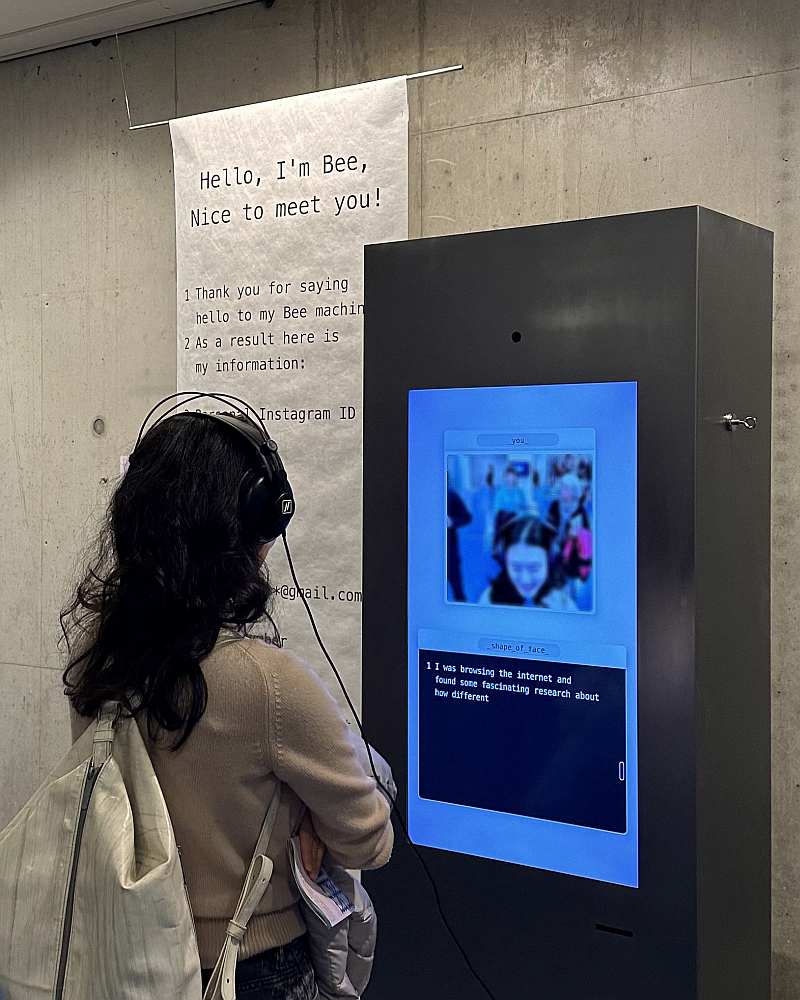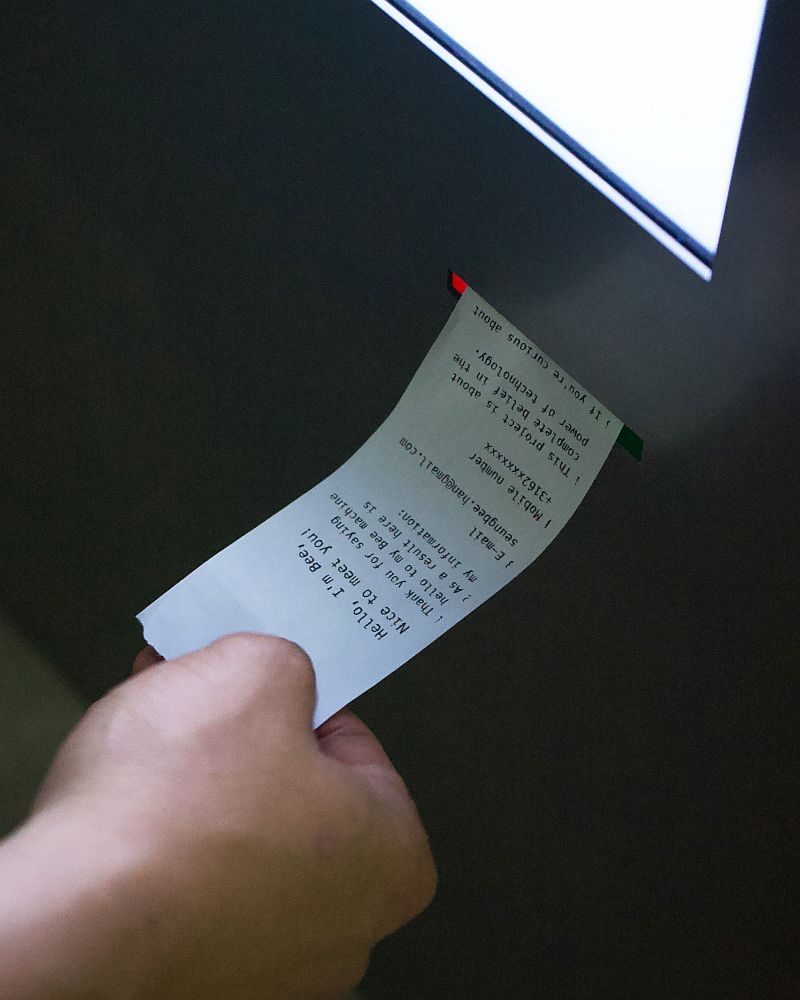Bee (Seungbee) Han graduated from Design Academy Eindhoven in 2023 with the Bee Machine. A machine that judges potential friends on the possible success rate of the friendship. Especially for Third Floor, she wrote about finding love and friendship through algorithms and AI.
“I like to think, and the sooner, the better! Of a cybernetic meadow where mammals and computers live together in mutually programming harmony, like pure water touching a clear sky.” — All Watched Over By Machines of Loving Grace - Poem by Richard Brautigan
Defining Love
What is ‘love’ in the present era? Born in 1997, I have been through phone booths and smartphones. I am a person who understands both analogue and digital technologies. For me, love is like a gateway to dopamine, like Netflix, Instagram and YouTube. People can interpret this feeling, but love has existed from the beginning. However, the forms through which we seek and accept love have changed with the advent of new media.
These changes can manifest in terms such as:
“Situationship”: A romantic or sexual relationship that is undefined and noncommittal.
“Date mate”: Individuals who enjoy dating without restraint under consented rules.
“썸” “Ssum” (Something): A Korean word that refers to a state in which individuals slightly like each other but are not officially dating.
Words like this dissect love into hundreds of different forms.
Changes in the Ways We Seek Love
As the meaning and forms of love change, so do the new ways of seeking love. We no longer need to go out every weekend to make eye contact with strangers to find someone to love. New forms of finding love, like dating apps, have been introduced thanks to those who suggested following options. Besides dating apps, unique methods exist in South Korea, where I’m originally from. These special methods are called ‘marriage information agencies.’ These agencies are legally referred to as marriage brokers and they work as follows:
– You contact an agency yourself. Although in some cases, they might contact you first if you appear to be prime marriage material; my friend got a call.
– You pay a nominal introduction fee.
– Then you provide all your data. This information includes age, height, income, parents’ assets, religion, and mandatory genetic disease information.
– The agency labels you based on your data and offers opportunities to meet people in the same category. They have a table that gives scores based on jobs, assets, and education. If your appearance is average, it will not affect your score, but if you have flaws in your weight or appearance, your score will be negative.
These methods help busy, modern individuals minimize mistakes and still find love.According to one marriage information agency, you have a 61% chance of finding a suitable partner within three months of registration. It is a science that has entered the realm of the emotion called love, matching people based on data and algorithms.
These changes have led me to think of a new way to find love in the future.
My Proposal for Finding Love
My graduation project, the ‘Bee Machine,’ is a new suggestion for finding love and friends. This machine, using my physiognomical preferences, shows how much I like a person based on appearance factors such as their similarity to certain animals and their similarity to me. Physiognomy is a study that has been studied since ancient times, in which a person’s future or personality is determined based on their facial features. For example, Aristotle’s theory about the relationship between what animals we look like and our personality, or theories about genetic characteristics that say people like people who look similar to them.

Although it is now dismissed as pseudoscience, some still call it science because it is based on people’s appearance data. It is similar to the horoscopes and fortune-telling we are familiar with. Based on physiognomy, I provided the machine with data about the type of person I prefer. After people let the machine scan their face, a success rate for a possible friendship is calculated by the algorithm. The result determines what personal information users can access: just my email address or everything, such as Instagram and phone numbers. In a sense, the machine knows me better than I know myself, because it makes a scientific decision based only on data and excludes human characteristics, such as changes in my mood and how drunk I am.

At the Graduation Show of Design Academy Eindhoven in 2023, I exhibited this machine version of myself. People were able to interact with the machine. How would people accept the results of this most personal machine, which was started and created by an individual? They stood in front of the machine, put their hands on their chests, and waited for the outcome. If the results were high, they would come to me with words of potential friendship; if the results were low, they would send me a sharp glance. When my friends tried it out, I was nervous and afraid of exposure. If I were to stand in front of these people and say: “You are the kind of person I would like about 20%”, they would snort and leave.
However, what I tried to convey through this project is that when data-ised information undergoes training through an algorithm, and the trained results are delivered back to people through the machine’s gaze, an unknown power is created there. Information before being converted into data is produced by humans, but when it delivered through machines the appearance of human becomes blurred.
My unintentional bias
The machine’s algorithm is trained on data that originates from my brain; it resembles me.
Despite the appearance of a clean, cold, and precise machine, I stand behind it, a human being who makes mistakes and wrong decisions. Sometimes, I may unknowingly trap myself in biased thinking and harbor prejudices.
Let me give you a real-life example of what happened during the graduation show.
Before this moment, I did not consider myself a person with biases; I have friends of various ages and races.
Firstly, the machine includes tests that compare how much the user looks like my besties and how much they look like me. I am an Asian woman who has lived in South Korea for 19 years, and my data features more Asian friends. To resemble me, they should have black hair and black eyes. It is not that I have biases, but my experience naturally shapes the data that is trained on the machine. Secondly, a disabled person asked if their handicap affected their results. I initially denied it, but later, I realised that their data were not included in my training set. It was the result of my limited input.
I said I didn’t think of myself as a biased person, but when I applied the data created from my experiences to the Bee machine, I was able to discover that I had biases that I didn’t even know I had.
The words “AI” and “technology” often seem hidden behind the cold metal, which is colourless and odourless. In reality, they may not be completely different from us; they are just data-ised versions of ourselves. We need to be aware that they, too, are humans like us and can make mistakes.
Things We Can Love
The data in my algorithm like YouTube and Instagram, is a collection of my experiences, what I’m familiar with, and things I have loved so far. This collection continuously informs me about what I can love in the future. Because the algorithms are scientifically analysing my heart, it seems like there is no way we cannot love what it recommends to us.
Now, we live in a society where we can put our laziness behind technology. The familiar things we have loved because of this laziness are so satisfying that we pretend not to be curious anymore about new things. It’s the Love in the Data Age. But the new way of finding love via data and algorithms may keep us stuck, because we might end up staying in the things we used to. And intoxicated by that familiarity, we may show unintentional bias against new and different things.
Data and algorithms allow us to quickly and easily find what we can love. Especially in this busy society, the content someone has prepared for me according to my taste is like having a personal assistant. However, we cannot quickly determine how the assistant give us that information. Missing out on the curiosity to seek out and explore new things and the happiness of accepting them is as immense a disadvantage as this new technology’s advantages. In this Love in the Data Age, where AI continuously recommends what we can love, we may need a voyage not just focusing on things we can love, but also on things we want to love.
